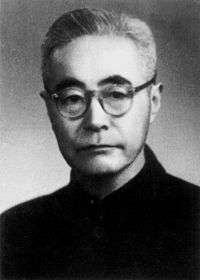Gu Jiegang
| Gu Jiegang | |||||||||||
|---|---|---|---|---|---|---|---|---|---|---|---|
|
Portrait of Gu Jiegang in 1954. | |||||||||||
| Born |
8 May 1893 Suzhou, Jiangsu, Qing Empire | ||||||||||
| Died | 25 December 1980 (aged 87) | ||||||||||
| Residence | China | ||||||||||
| Citizenship | Chinese | ||||||||||
| Fields | Chinese historian | ||||||||||
| Alma mater | Peking University | ||||||||||
| Known for | Yigupai | ||||||||||
| Influences | Liang Qichao, Zhang Binglin, Kang Youwei, Zhang Sizhao, Hu Shih | ||||||||||
| Chinese name | |||||||||||
| Traditional Chinese | 顧頡剛 | ||||||||||
| Simplified Chinese | 顾颉刚 | ||||||||||
| |||||||||||

Gu Jiegang (8 May 1893 – 25 December 1980) was a Chinese historian best known for his seven-volume work Gushi Bian (古史辨, or Debates on Ancient History). He was a co-founder and the leading force of the Doubting Antiquity School, and was highly influential in the 20th century development of Chinese history.
Biography
Gu Jiegang was born two years before China's defeat in the First Sino-Japanese War. The country during his early years was wrought with turmoil. During high school, Gu briefly joined a revolutionary group during the 1911 Revolution. However, he soon realized that he had "no personal aptitude for politics, and no ability in promoting great social movements". He developed an interest in history while being a student at Peking University, and resolved to use a new historical narrative to calm his country's social and political turmoil.[1]
When the Cultural Revolution started in 1966, Gu was labeled a Reactionary Scholarly Authority. He had to wear a dunce cap and was subjected to struggle sessions. He had to labor at the History Department every day until he was freed in the early 1970s.
Historiography
Gu has been viewed as something of an enigma by many scholars. His work has been characterized as scientific and anti-tradition, while at the same time showing pride in Chinese culture and believing that the Chinese identity would withstand modernization. The German scholar Ursula Richter characterized this discrepancy by labeling Gu "the traditional and yet modern scholar who was true to tradition also in that he 'obeyed yet resisted'".[2]
According to Laurence Schneider, the "most persistent theme" in Gu's writings is "the central role of the intellectual in Chinese history, and the centrality of history to the Chinese intellectual".[3] He attributed China's failure to modernize to opportunistic intellectuals who allied with the aristocracy, rather than pursuing truth. In order to restore China to greatness, Gu, along with his mentor Hu Shi, advocated a non-political role for Chinese intellectuals, against the emerging trend of Marxist histories.[4]
To this end, Gu used textual criticism to challenge traditional Chinese historiography. One example is the myth of the Three Sovereigns and Five Emperors, a supposed golden age in China's antiquity that had scarcely been doubted up to the present. It is important to note that Gu's purpose in questioning the historicity of this myth was not only to rectify errors in understanding, but also to destroy the entire philosophy of history that revolved around looking back to this supposed golden age.[5]
Gu is also known for his theory of Chinese diversity, as opposed to the idea of Chinese homogeneity, which is the main assumption of hanism. He states that there is no such thing as the Chinese national identity. This is a bold remark, considering the fact that he was living in a period of fundamental change and the period of pan-hanism in China.
References
- ↑ Hon, Tze-Ki (1996). "Ethnic and Cultural Pluralism: Gu Jiegang's Vision of a New China in His Studies of Ancient History". Modern China. 22 (3): 315–339. doi:10.1177/009770049602200303. ISSN 0097-7004. JSTOR 189190.
- ↑ Hon (1996), pp. 315-316.
- ↑ Schneider, Laurence A. (1969). "From Textual Criticism to Social Criticism: The Historiography of Ku Chieh-kang". The Journal of Asian Studies. Association for Asian Studies. 28 (4): 771–788. doi:10.2307/2942411. JSTOR 2942411.
- ↑ Schneider (1969), pp. 771-772
- ↑ Schneider (1969), p. 772
Further reading
- Richter, Ursula (1982). "Obituary: Gu Jiegang (1893–1980)". The Journal of Asian Studies. 41 (2): 441–442. doi:10.1017/s0021911800073290. JSTOR 2055029.
- —— (1994). "Historical Scepticism in the New Culture Era: Gu Jiegang and the 'Debate on Ancient History'" (PDF). 近代中國史研究通訊 Jìndài Zhōngguó Shǐ Yánjiū Tōngxùn. 23: 355–388.
- Schneider, Laurence A. (1971). Ku Chieh-kang and China’s New History: Nationalism and the Quest for Alternative Traditions. Berkeley: University of California Press. ISBN 978-0-520-01804-4.
